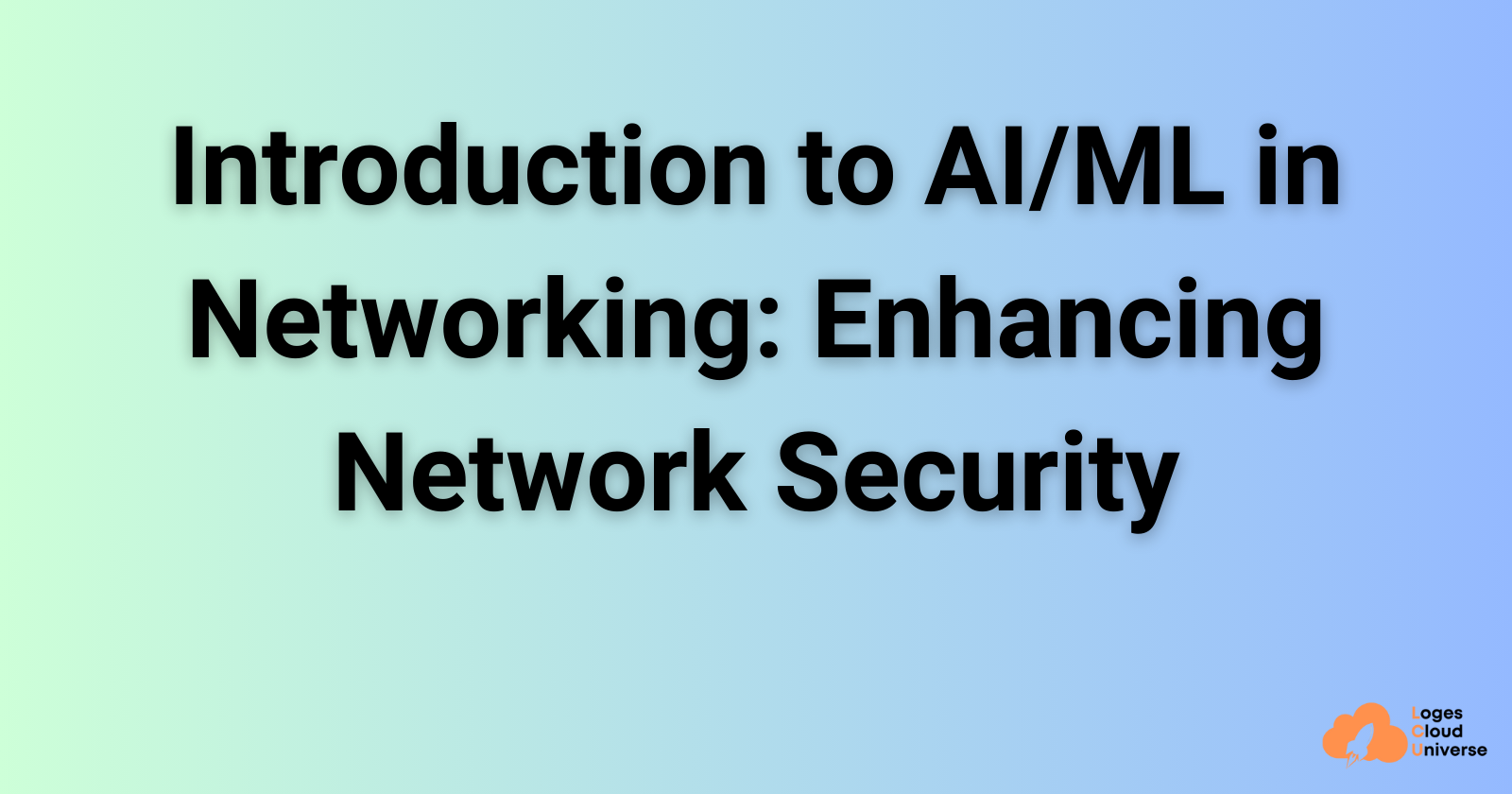Introduction to AI/ML in Networking: Enhancing Network Security
 Logeswaran
LogeswaranTable of contents
- Current Problem
- Objective
- Setting Assumptions
- Prerequisites
- Key Concepts
- Definition and Explanation
- Analogies
- Detailed Explanation
- Anomaly Detection
- Predictive Analytics
- Automation
- Example Use Case
- Real-World Example
- Step-by-Step Guide
- Step 1: Collect Network Data
- Step 2: Train an ML Model
- Step 3: Deploy the Model
- Tools and Platforms
- Conclusion
- Recap of Key Points
- Call to Action

Hello Cloud Learners,
I’m happy to inform that recently completed my Terraform associate exam and this enhanced my AWS upskilling in many ways. I would strongly recommend to take this exam if you are planning to learn AWS in effective way.
Here is my previous post about Securing Serverless Functions with IAM Roles and Policies
Let’s jump into our today’s interesting and security topic.
Imagine a network that can predict and prevent cyber threats before they occur, much like a skilled security guard anticipating potential intruders. This is the future of networking with Artificial Intelligence (AI) and Machine Learning (ML). AI/ML technologies are revolutionizing network security by enabling systems to detect anomalies, predict threats, and respond autonomously.
Current Problem
Traditional network security systems often rely on predefined rules and signatures to identify threats. However, modern cyber threats are increasingly sophisticated and dynamic, making it challenging for traditional systems to keep up. This is where AI/ML comes into play, offering a proactive approach to network security.
Objective
In this post, we will introduce the concept of AI/ML in networking, focusing on how these technologies can enhance network security. By the end of this guide, you will have a solid understanding of the role AI/ML plays in improving network resilience and security.
Setting Assumptions
To follow this guide effectively, we assume you have a basic understanding of networking concepts and some familiarity with AI/ML principles. If you're new to AI/ML or networking, it might be helpful to start with introductory resources on these topics before diving into this guide.
Prerequisites
To explore AI/ML in networking, you will need:
Basic Knowledge of Networking: Familiarity with network protocols and security concepts.
Basic Understanding of AI/ML: Knowledge of AI/ML fundamentals, including machine learning algorithms and deep learning.
Access to AI/ML Tools: Familiarity with tools like TensorFlow, PyTorch, or AWS SageMaker for practical experimentation.
Key Concepts
Definition and Explanation
AI/ML in Networking involves using artificial intelligence and machine learning algorithms to analyze network traffic, detect anomalies, predict potential threats, and automate responses. This proactive approach enhances network security by identifying threats that traditional systems might miss.
Anomaly Detection: AI/ML models can identify unusual network activity that may indicate a security threat.
Predictive Analytics: These models can predict when and how threats are likely to occur, allowing for proactive measures.
Automation: AI/ML can automate security responses, reducing the time to mitigate threats.
Analogies
To simplify these concepts, consider the following analogies:
Anomaly Detection: Think of it like a surveillance system that flags unusual behavior in a public place. Just as the system alerts security personnel to potential threats, AI/ML models alert network administrators to unusual network activity.
Predictive Analytics: Compare it to weather forecasting. Just as weather models predict storms, AI/ML models predict potential security threats based on historical data and patterns.
Detailed Explanation
Anomaly Detection
Anomaly detection involves training ML models on normal network traffic patterns. These models can then identify deviations from these patterns, which might indicate malicious activity. For example, if a model notices a sudden spike in login attempts from an unknown IP address, it can flag this as an anomaly.
Predictive Analytics
Predictive analytics uses historical data and machine learning algorithms to forecast potential security threats. This can include predicting when a DDoS attack might occur or identifying vulnerabilities that attackers are likely to exploit.
Automation
Automation involves using AI/ML to trigger responses to detected threats. For instance, if an AI system detects a potential threat, it can automatically block traffic from the suspicious IP address or alert security teams for further action.
Example Use Case
Scenario: A company uses AI/ML to monitor its network for anomalies. The system detects unusual traffic patterns indicating a potential malware outbreak. Based on predictive analytics, the system forecasts that this could lead to a larger security incident if not addressed promptly.
Solution: The AI/ML system automatically triggers a response by isolating affected devices and alerting security teams to investigate and mitigate the threat.
Real-World Example
Let's consider a real-world example where AI/ML significantly enhanced network security:
Case Study: A major financial institution implemented an AI-powered network monitoring system to detect and respond to cyber threats. The system used machine learning algorithms to analyze network traffic and identify anomalies. Within the first month, it detected several potential threats that traditional systems had missed, including a sophisticated phishing attempt and a malware infection. The AI system automatically blocked these threats, preventing any data breaches.
Impact: The institution reported a significant reduction in security incidents and improved response times to threats, thanks to the proactive nature of the AI/ML system.
Step-by-Step Guide
Here's a step-by-step guide to implementing AI/ML for network security:
Step 1: Collect Network Data
Network Traffic Capture: Use tools like Wireshark or AWS VPC Flow Logs to capture network traffic data.
Data Preprocessing: Clean and preprocess the data for ML model training.
Step 2: Train an ML Model
Choose an Algorithm: Select an appropriate ML algorithm for anomaly detection or predictive analytics (e.g., One-Class SVM, Autoencoders).
Train the Model: Use a dataset of normal network traffic to train the model.
Validate the Model: Validate the model's performance using a test dataset.
Step 3: Deploy the Model
Integration with Network Systems: Integrate the trained model with your network monitoring system.
Real-Time Analysis: Configure the system to analyze network traffic in real-time.
Automate Responses: Set up automated responses to detected threats (e.g., blocking suspicious traffic).
Tools and Platforms
AWS SageMaker: Use SageMaker for building, training, and deploying ML models.
TensorFlow or PyTorch: Utilize these frameworks for developing custom ML models.
Conclusion
AI/ML technologies are transforming network security by enabling proactive threat detection and response. By integrating AI/ML into your network security strategy, you can significantly enhance your network's resilience against modern cyber threats.
Recap of Key Points
Anomaly Detection: AI/ML models identify unusual network activity.
Predictive Analytics: Forecast potential threats based on historical data.
Automation: Automate security responses to detected threats.
Real-World Example: AI/ML implementation in a financial institution improved threat detection and response.
Call to Action
Now that you've learned about the potential of AI/ML in enhancing network security, consider implementing these technologies in your own network environment. Share your experiences or ask questions in the comments below. If you have specific scenarios or challenges, feel free to describe them, and we'll help you find a solution.
This guide provides a comprehensive introduction to AI/ML in networking, focusing on how these technologies can enhance network security. By applying these principles, you can significantly improve your network's ability to detect and respond to cyber threats proactively.
Let's grow each other and build strong cloud hands-on skills!
Follow me on LinkedIn for more AWS Cloud computing knowledge.
Happy Learning!
Cheers,
Logeswaran GV
Subscribe to my newsletter
Read articles from Logeswaran directly inside your inbox. Subscribe to the newsletter, and don't miss out.
Written by

Logeswaran
Logeswaran
Curious to learn new things and cloud computing enthusiast.